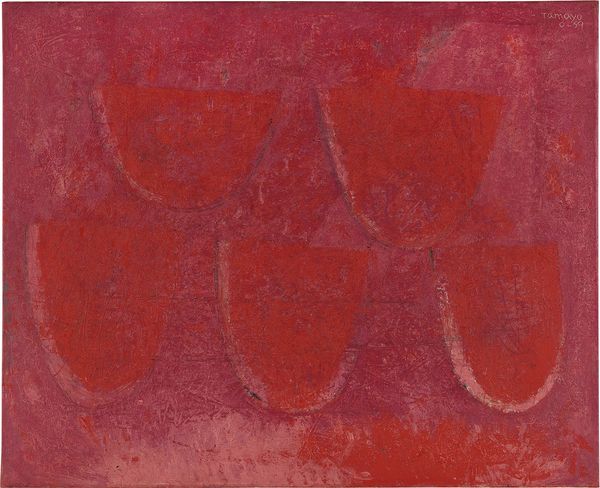Rufino Tamayo Cinco Rebandas de Sandía, 1959. Estimate: $1,000,000-1,500,000.
20th Century & Contemporary Art Evening Sale at Phillips New York, 14 November.
By Juan Carlos Pareda, Art Historian and Deputy Director of the Museo Rufino Tamayo, Mexico City
In 1959, Rufino Tamayo’s sojourn in Europe was coming to an end. During his time in Paris, the painter experimented with his color palette, which became more complex and sophisticated, resulting in an evolution in the synthesis of his images. Hailing from Oaxaca, Mexico, Tamayo had grown in recognition exponentially in Europe, and was finally being appreciated as a mature artist. Solo exhibitions of his work took place in Italy, Norway, England, France and Switzerland; and even as he continued to work with the New York-based Knoedler Gallery, art galleries began to represent him in each of these countries. By 1959 Tamayo’s prestige had reached a culminating point.
At a time when Abstract Expressionism and Art Informel dominated the international art scene, Tamayo’s work continued to be widely celebrated by the public despite the persistently representational nature of his paintings. Even as his imagery became increasingly schematic, it never leapt into complete abstraction. This is the context in which Cinco Rebanadas de Sandía, 1959 was created. Although, in essence, it is a still life—a classical painting genre—it is nevertheless transformed by Tamayo’s novel and harmonious approach.
Diego Rivera Watermelons (Las sandías), 1957. Museo Dolores Olmedo Patiño, Mexico City, Photo credit Schalkwijk/Art Resource, NY, Artwork © 2019 Banco de México Diego Rivera Frida Kahlo Museums Trust, Mexico, D.F./Artists Rights Society (ARS), New York
Tamayo’s still lifes, such as Cinco Rebanadas de Sandía from the Collection of Florence Knoll Bassett, are conceived of their own set of conditions set forth by the artist. Primarily, Tamayo ushered in the reinvention of a traditional pictorial genre through his inventive approach. His singular aesthetic quality frees the object from a merely decorative function. Rendered with a stylization that sets them apart from mimesis, the fruit slices float over a shimmering field of color, whose richness derives as much from splotches in different shades of pink, red, orange and sepia, as they do from intervening sgraffiti of an expressionist nature. Combined, these elements lend the composition a dynamism that contradicts the very essence of the pictorial genre to which the painting belongs: stillness.
Cinco Rebanadas de Sandía recounts the technical and conceptual resources that Tamayo had accomplished by the date of its completion. The seemingly simple shapes allow the viewer’s attention to focus on the plastic solutions applied to form, color and, most importantly, to the intimate way in which he approaches the space occupied by the varied shapes of the fruit. It is noteworthy that there are no two slices of watermelon alike; each piece has its own identity inside the composition, all the while resulting in a harmonic whole. In an avant-garde gesture, Tamayo has added patches of pink and red pigment to the base of the composition as a spatial index. Barely visible green brushstrokes add chromatic balance to the surface. Regarding color, Tamayo’s unparalleled mastery in handling sophisticated spectrums of red, pink, sepia, white and gray placed him as a master colorist of the 20th century, as unequivocally demonstrated in this painting. The contrast between the improbable pinks and the reds, oranges and sepias mediated by the singular “Tamayo pink,” which grazes each slice of fruit, makes this canvas one of the most characteristic examples of the artist’s mature style.
Cinco Rebanadas de Sandía was exhibited the year of its execution at Knoedler Gallery. Evidencing its importance as a key example of Tamayo’s mature period, it was chosen to grace the exhibition catalogue cover in detail, although it was mysteriously illustrated upside down. Florence Knoll Bassett purchased the work that same year, and it has not been exhibited since.

